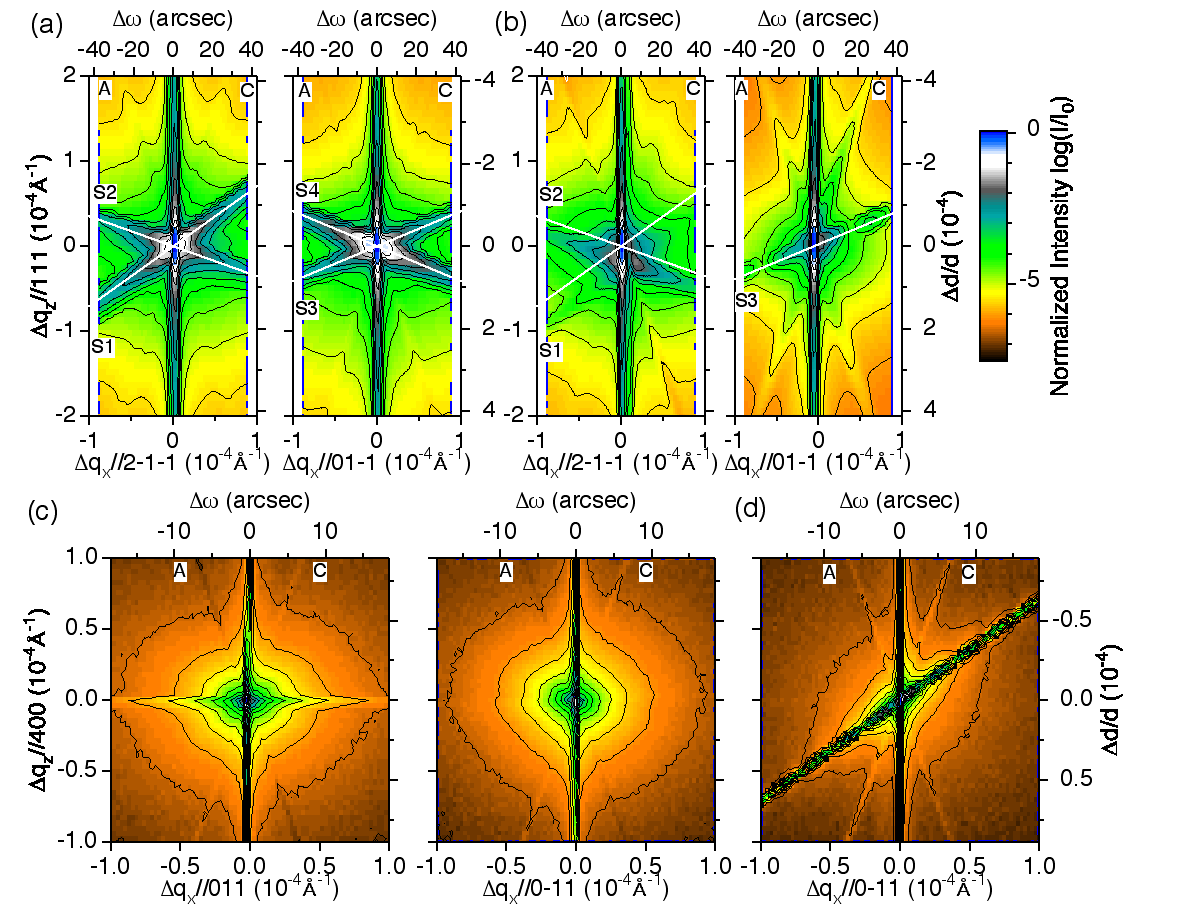Reciprocal space mapping
問い合わせ番号
SOL-0000001061
ビームライン
BL29XU(理研 物理科学I)
学術利用キーワード
| A. 試料 | 無機材料 |
|---|---|
| B. 試料詳細 | 結晶 |
| C. 手法 | X線回折 |
| D. 手法の詳細 | 単結晶構造解析 |
| E. 付加的測定条件 | |
| F. エネルギー領域 | X線(4~40 keV) |
| G. 目的・欲しい情報 | 局所構造, 欠陥、転位、歪み |
産業利用キーワード
| 階層1 | 半導体 |
|---|---|
| 階層2 | シリコン系半導体, 化合物半導体 |
| 階層3 | ゲート絶縁膜, 層間絶縁膜, SOI,基板 |
| 階層4 | 表面・界面, 格子定数, 局所構造 |
| 階層5 | 反射率, X線散乱 |
分類
A80.12 半導体・電子材料
利用事例本文
Reciprocal space mapping gives the knowledge of intensity distribution in the reciprocal space, which relates, for example, fluctuation of lattice constant and tilt of the lattice plane. Such information is difficult to be extracted from rocking curve measurements and x-ray topography.
The following figures show reciprocal space maps of synthetic diamonds. Sample (a) had stronger oblique streaks than sample (b), which indicated the sample (a) included more 111 stacking faults. No sign of stacking fault was observed for sample (c), however, the horizontal streak indicated bend of the lattice plane.
[ K. Tamasaku, T. Ueda, D. Miwa and T. Ishikawa, Journal of Physics D 38, A61-A66 (2005), Fig. 3,
©2005 Institute of Physics and IOP Publishing, Ltd. ]
画像ファイルの出典
原著論文/解説記事
誌名
K. Tamasaku et al, J. Phys. D: Appl. Phys. 38, A61 (2005)
図番号
測定手法
Prepare collimator and analyzer crystals which have a lattice constant close to the sample.
Set the collimator, the sample, and the analyzer non-dispersively, and find reflections for all crystals.
Scan the sample and the analyzer so as to map out the region of interest in the reciprocal space.
画像ファイルの出典
図なし
測定準備に必要なおおよその時間
1 日
測定装置
| 装置名 | 目的 | 性能 |
|---|---|---|
| goniometers | to align the crystals | 1/720000 deg. angular resolution |
参考文献
| 文献名 |
|---|
| A.Iida, and K.Kohra, Phys. Status Solidi a 51, 533 (1990). |
| K.Tamasaku, T. Ueda, D. Miwa, and T. Ishikawa, J. Phys. D: Appl. Phys. 38, A61 (2005). |
関連する手法
x-ray topography
rocking curve
アンケート
本ビームラインの主力装置を使っている
測定の難易度
中程度
データ解析の難易度
中程度
図に示した全てのデータを取るのにかかったシフト数
4~9シフト
